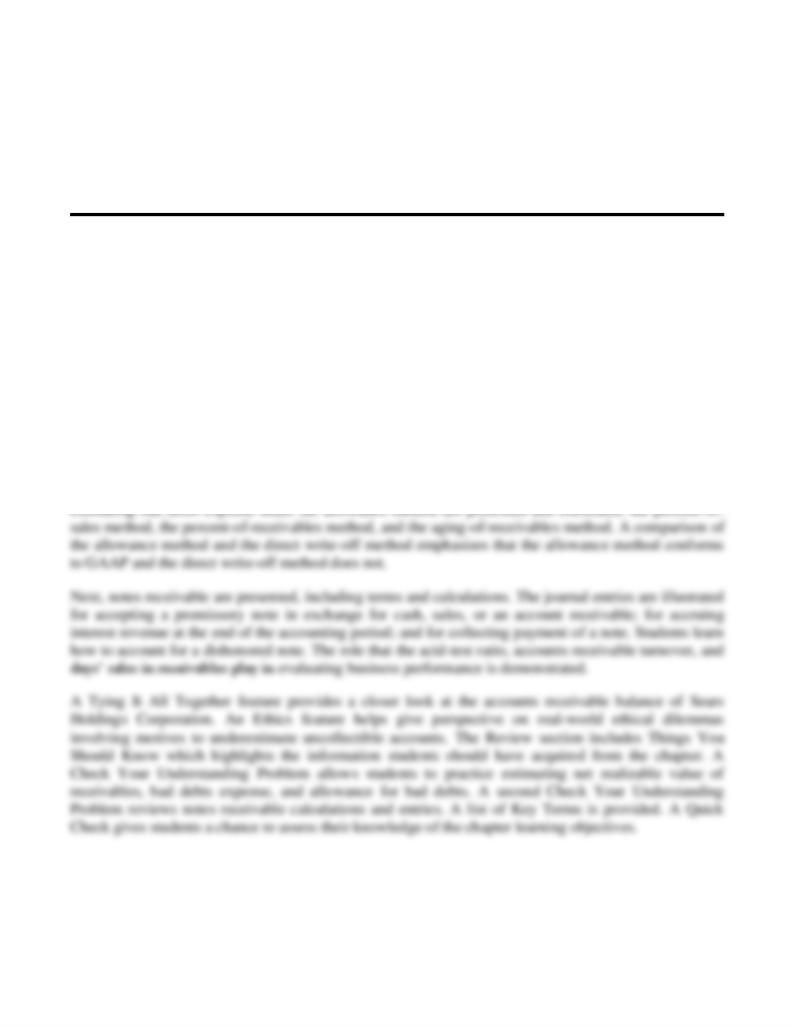
Chapter 8
Receivables
Chapter 8: Overview
The chapter begins with an overview of various types of receivables: accounts receivable, notes
receivable, and other receivables. Internal controls over receivables, the duties of the credit department,
recording sales on credit, and factoring and pledging receivables are presented. Two methods for
recording uncollectible accounts are discussed: the direct write-off method and the allowance method.
Under the direct write-off method, entries are illustrated for writing off uncollectible accounts as an
expense in the period in which they are recognized as being uncollectible and for recovering accounts
previously written off. The limitations of the direct write-off method are discussed. Next, the allowance
method is presented, and the contra asset account, Allowance for Bad Debts, is introduced as the means
by which receivables are reported on the balance sheet at their net realizable value. Journal entries for
estimating the expense associated with uncollectible accounts and creating the related allowance in the
period sold, writing off uncollectible accounts against the allowance previously created, and recovering
an account previously written off are illustrated under the allowance method. Three methods for
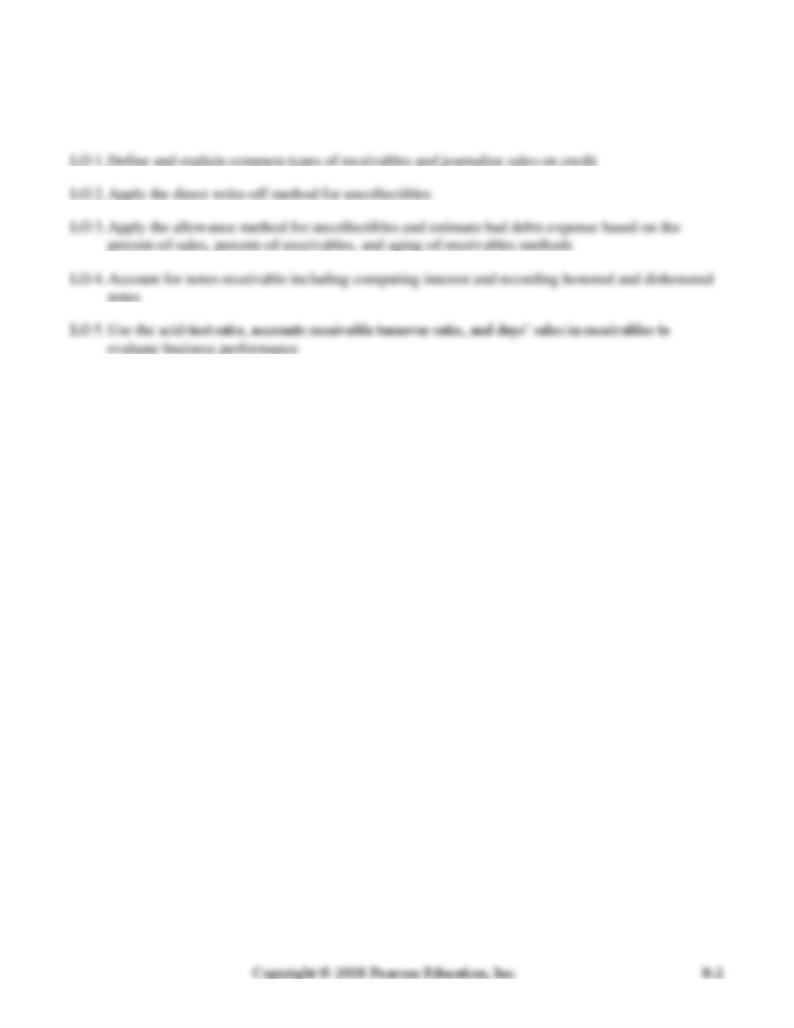
Chapter 8: Learning Objectives
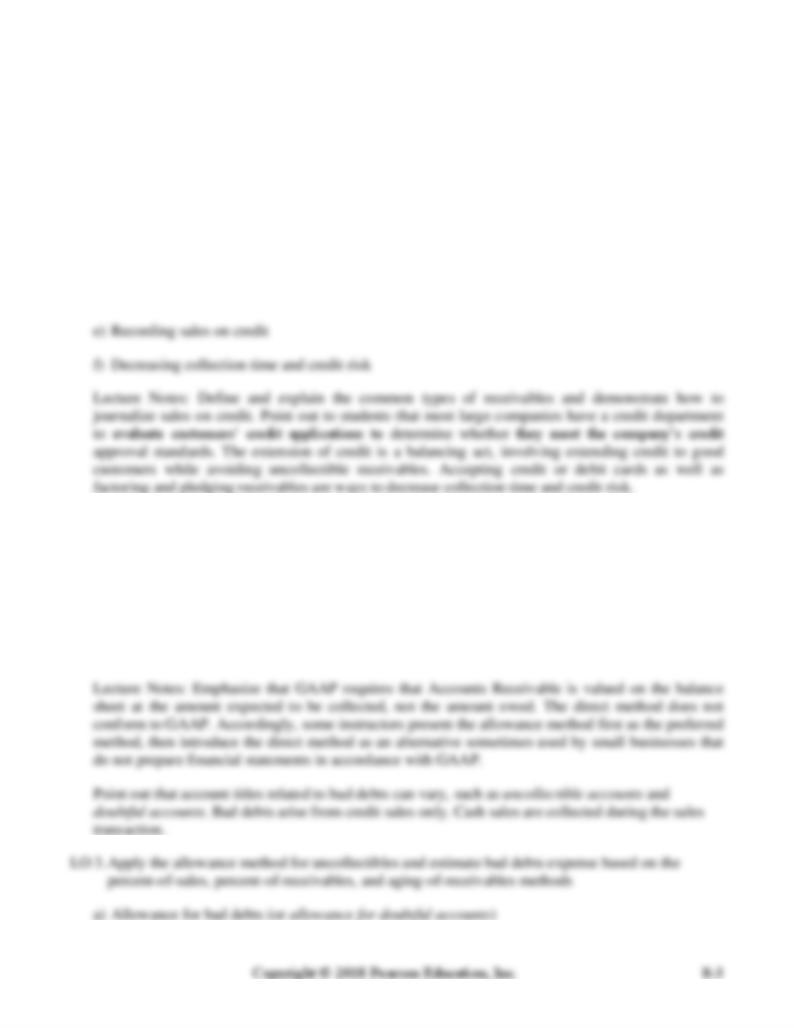
Chapter 8: Teaching Outline with Lecture Notes
LO 1. Define and explain common types of receivables and journalize sales on credit
a) Accounts receivable (or trade receivables)
b) Notes receivable
c) Other receivables
d) Exercising internal control over receivables
LO 2. Apply the direct write-off method for uncollectibles
a) Bad debts expense (or doubtful accounts expense or uncollectible accounts expense)
b) Recording and writing off uncollectible accounts
c) Recovery of accounts previously written off
d) Limitations

b) Recording bad debts expense
c) Writing off uncollectible accounts
d) Recovery of accounts previously written off
e) Estimating and recording bad debts expense
i. Percent-of-sales: Bad Debt Expense = Net Credit Sales × Percentage
ii. Percent-of-receivables: Two-step process
iii. Aging-of-receivables: Two-step process
▪ Exhibit 8-1: Aging of Accounts Receivable
f) Comparison of accounting for uncollectibles
i. Exhibit 8-2: Direct Write-off Method Versus Allowance Method
ii. Exhibit 8-3: Comparison of Percent-of-Sales, Percent-of-Receivables, and Aging-of-
Receivables Methods
Lecture Notes: The amount expected to be collected is referred to as net realizable value and is
calculated as the total amount owed minus an allowance for an estimated amount not expected to be
collected.
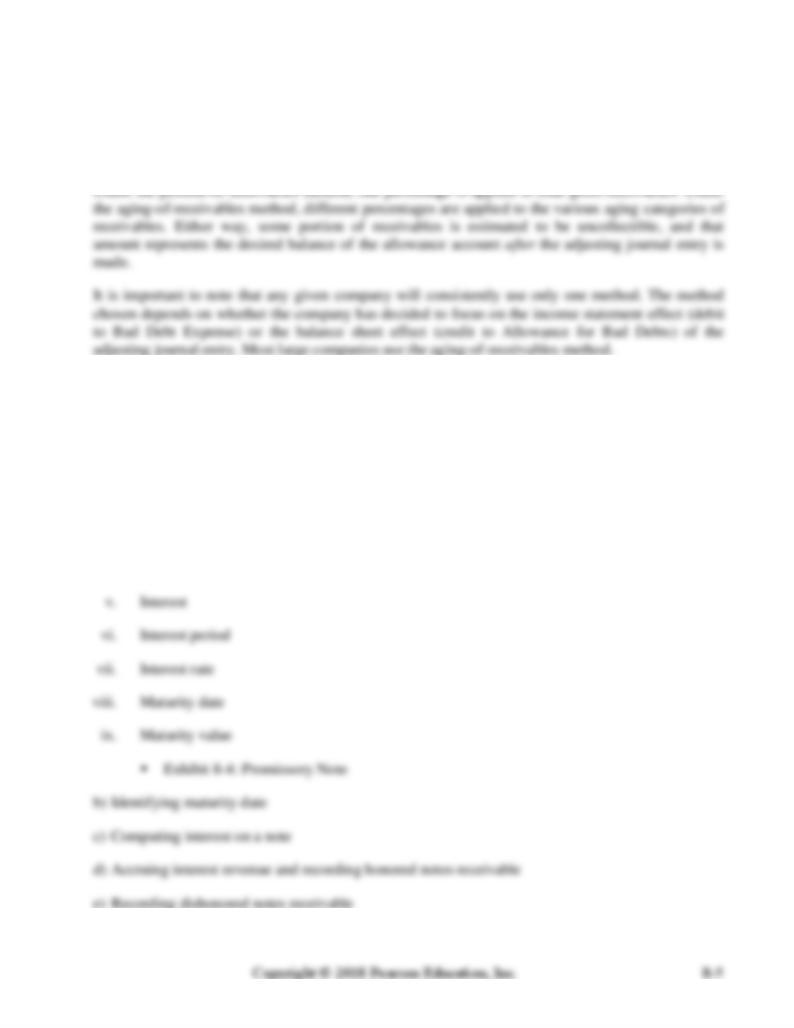
When using the balance sheet approach, the amount of the journal entry is the dollar amount needed
to change the balance of the allowance account so that it is equal to a predetermined percentage of
total receivables; that is, the dollar amount of the adjusting journal entry is the difference between
the unadjusted balance of the allowance account and the desired balance.
LO 4. Account for notes receivable including computing interest and recording honored and dishonored
notes
a) Define and explain the following terms:
i. Promissory note
ii. Maker of a note (debtor)
iii. Payee of a note (creditor)
iv. Principal
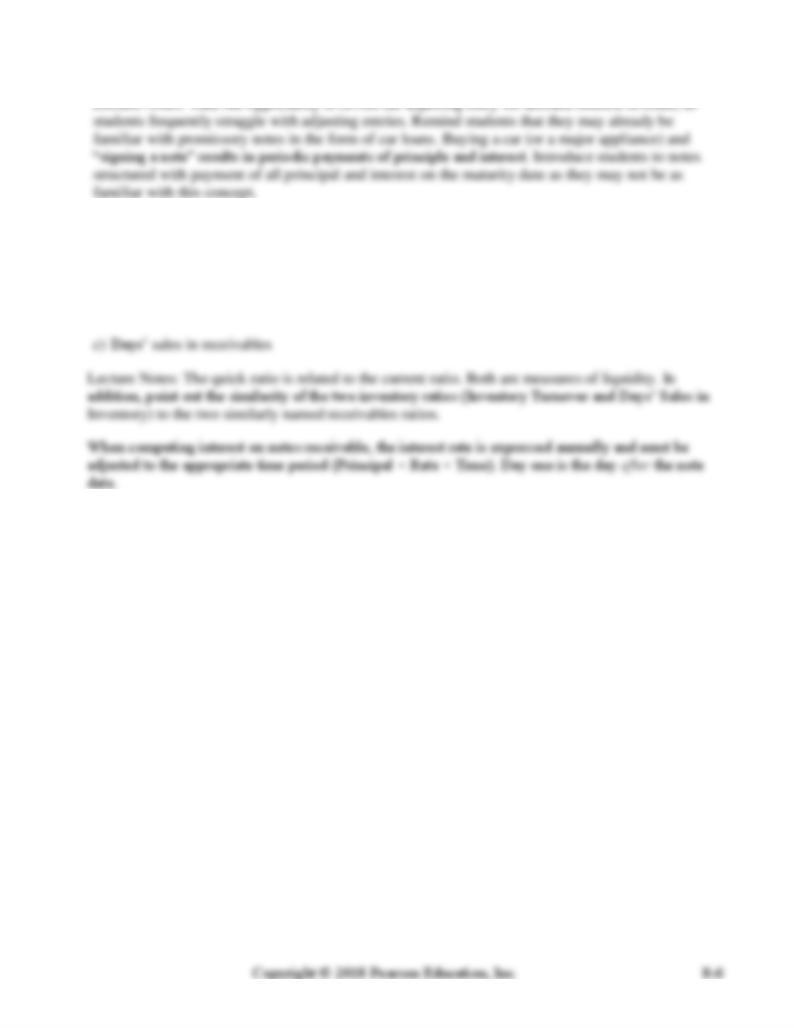
LO 5. Use the acid-test ratio, accounts receivable turnover ratio, and days’ sales in receivables to
evaluate business performance
a) Acid-test (or quick) ratio
b) Accounts receivable turnover ratio

Chapter 8: Handout for Student Notes
LO 1. What are common types of receivables, and how are credit sales recorded?
LO 2. How are uncollectibles accounted for when using the direct write-off method?
LO 3. How are uncollectibles accounted for when using the allowance method?
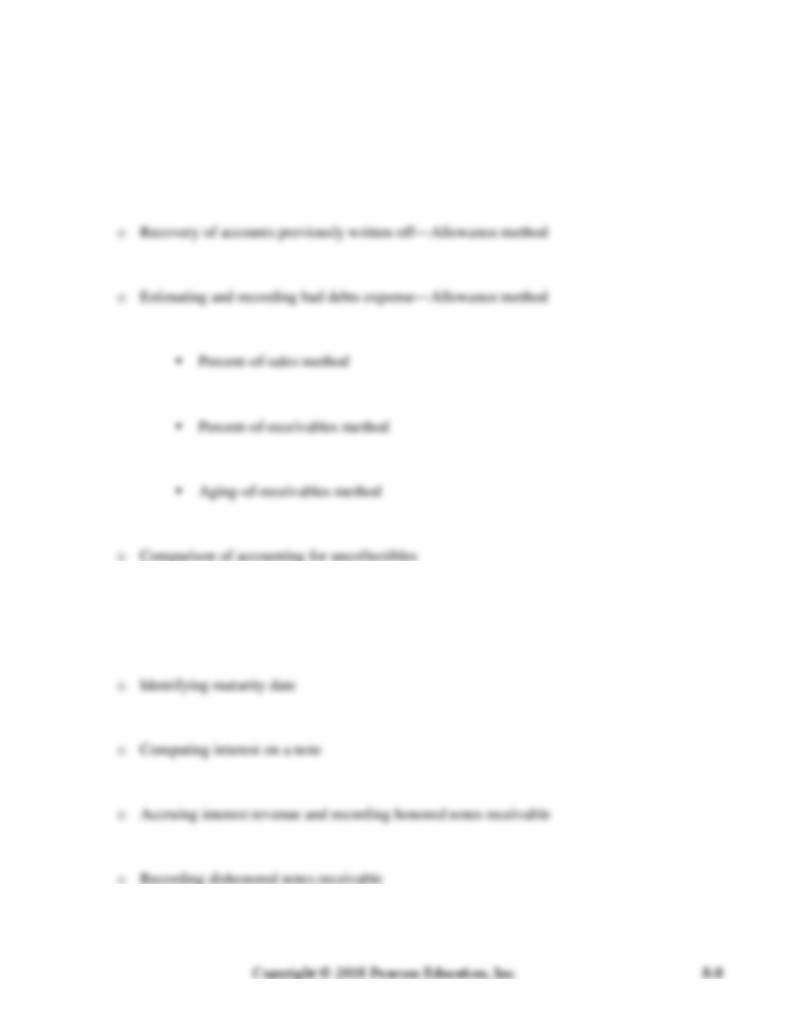
o Recording bad debts expense—Allowance method
o Writing off uncollectible accounts—Allowance method
LO 4. How are notes receivable accounted for?
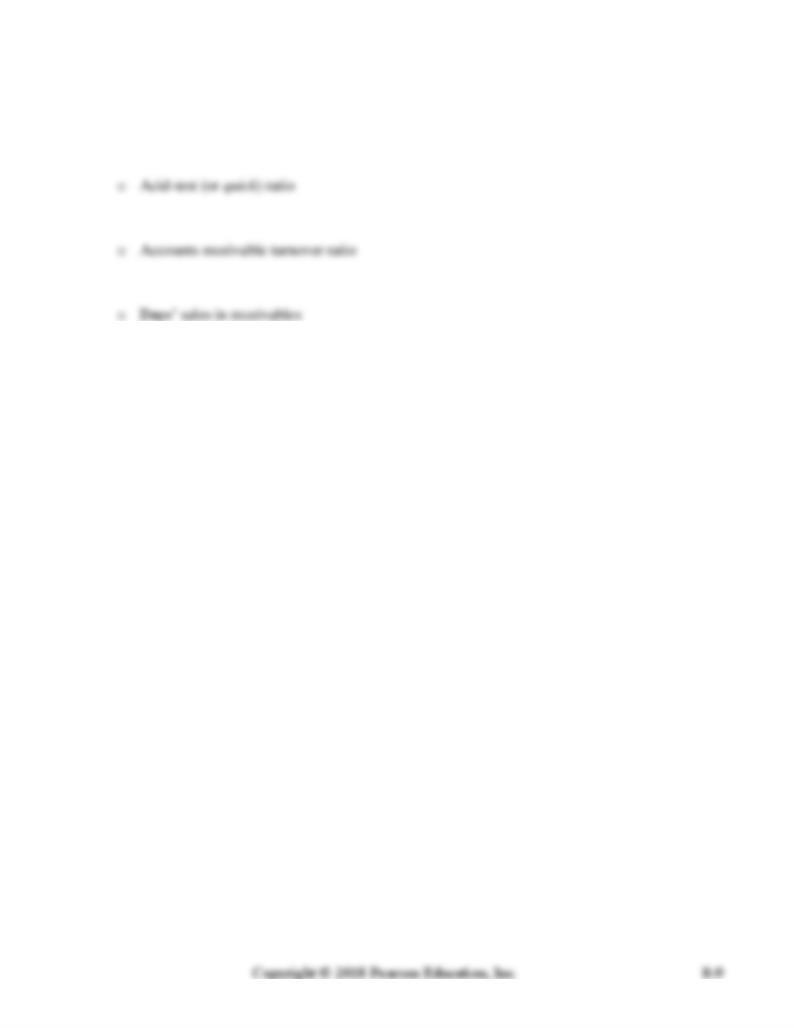
LO 5. How do we use the acid-test ratio, accounts receivable turnover ratio, and days’ sales in
receivables to evaluate business performance?
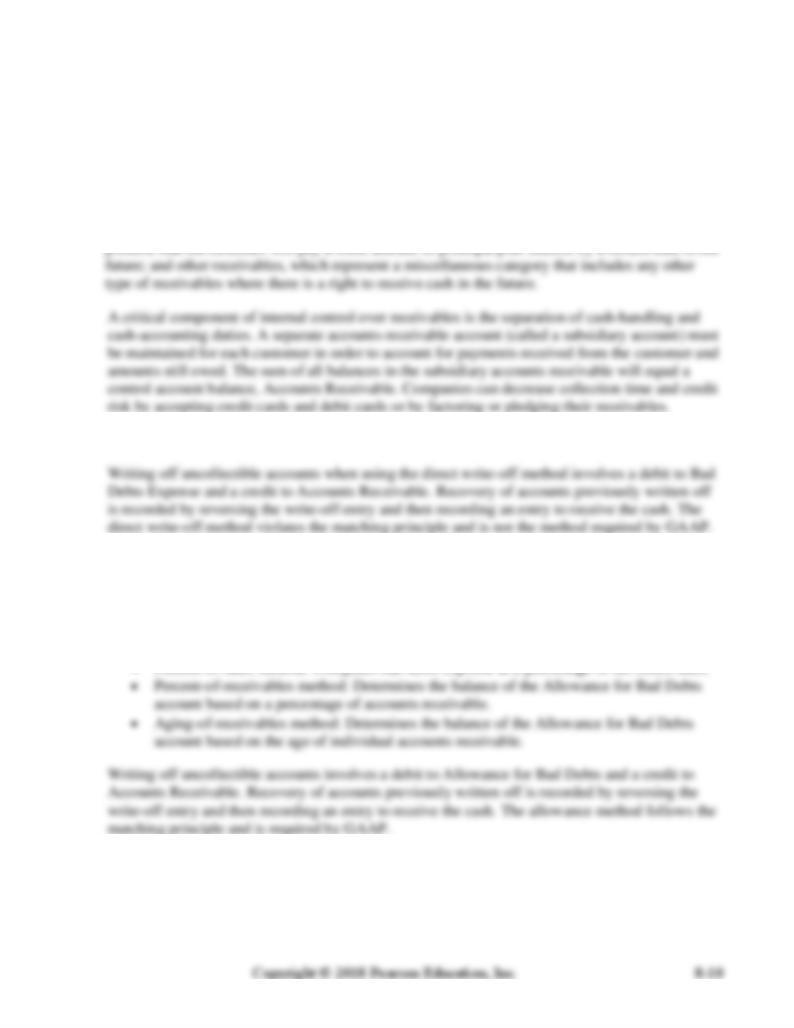
Chapter 8: Student Chapter Summary
LO 1. Define and explain common types of receivables and journalize sales on credit
A receivable is a monetary claim against a business or an individual. There are three major types
of receivables: accounts receivable, which represent the right to receive cash in the future from
customers for goods sold or for services performed; notes receivable, which represent a written
LO 2. Apply the direct write-off method for uncollectibles
LO 3. Apply the allowance method for uncollectibles and estimate bad debts expense based on the
percent-of-sales, percent-of-receivables, and aging-of-receivables methods
When using the allowance method, companies estimate bad debts expense at the end of the period
and record an adjusting entry that debits Bad Debts Expense and credits Allowance for Bad Debts.
There are three ways to estimate bad debts expense:
• Percent-of-sales method: Computes bad debts expense as a percentage of net credit sales.
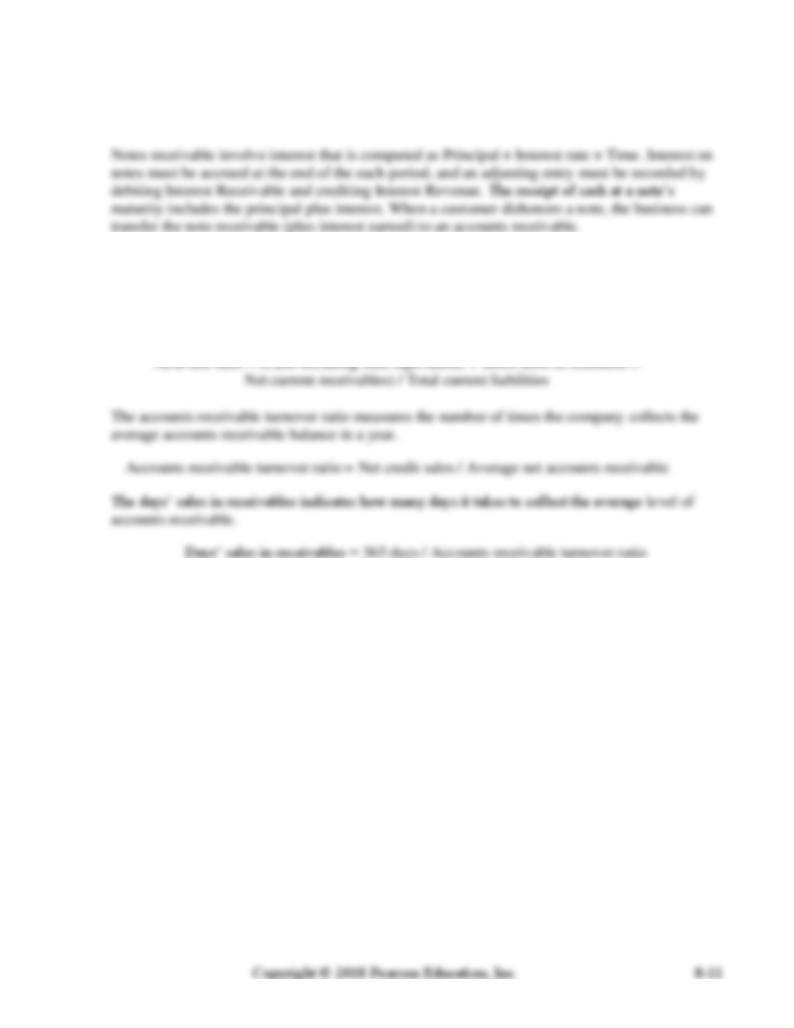
LO 4. Account for notes receivable including computing interest and recording honored and dishonored
notes
LO 5. Use the acid-test ratio, accounts receivable turnover ratio, and days’ sales in receivables to
evaluate business performance
The acid-test ratio reveals whether an entity could pay all its current liabilities if they were due
immediately.
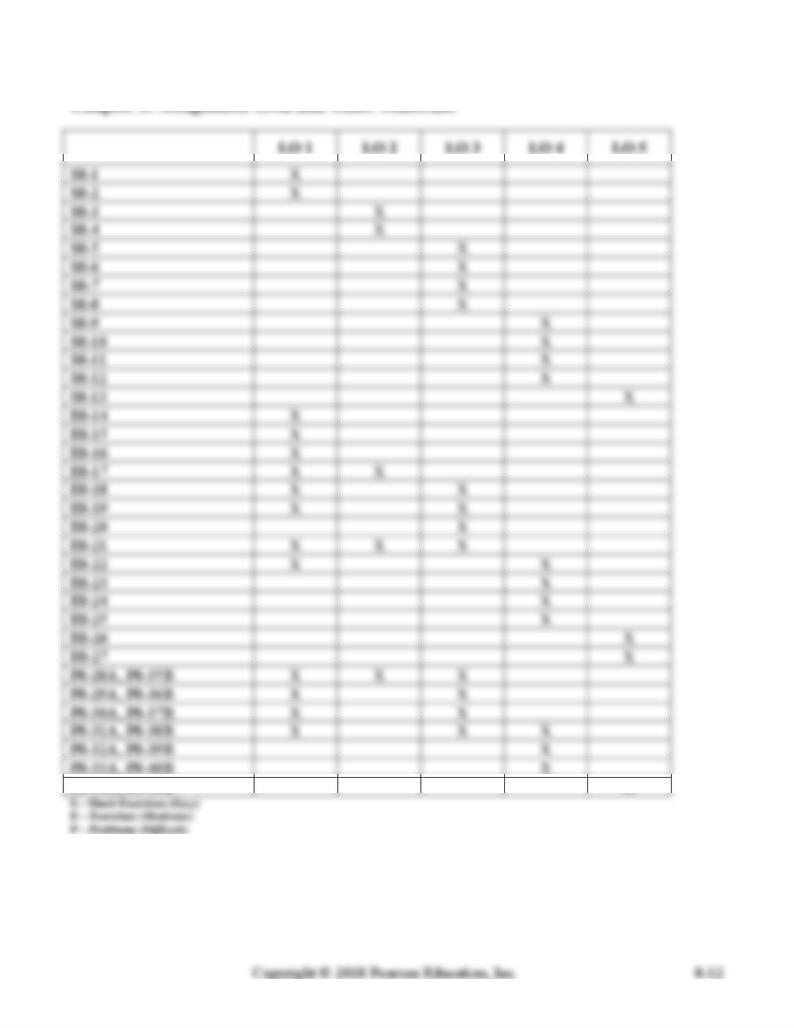
Chapter 8: Assignment Grid and Other Materials
P8-34A, P8-41B
X

Other End-of-Chapter Materials:
Using Excel P8-42
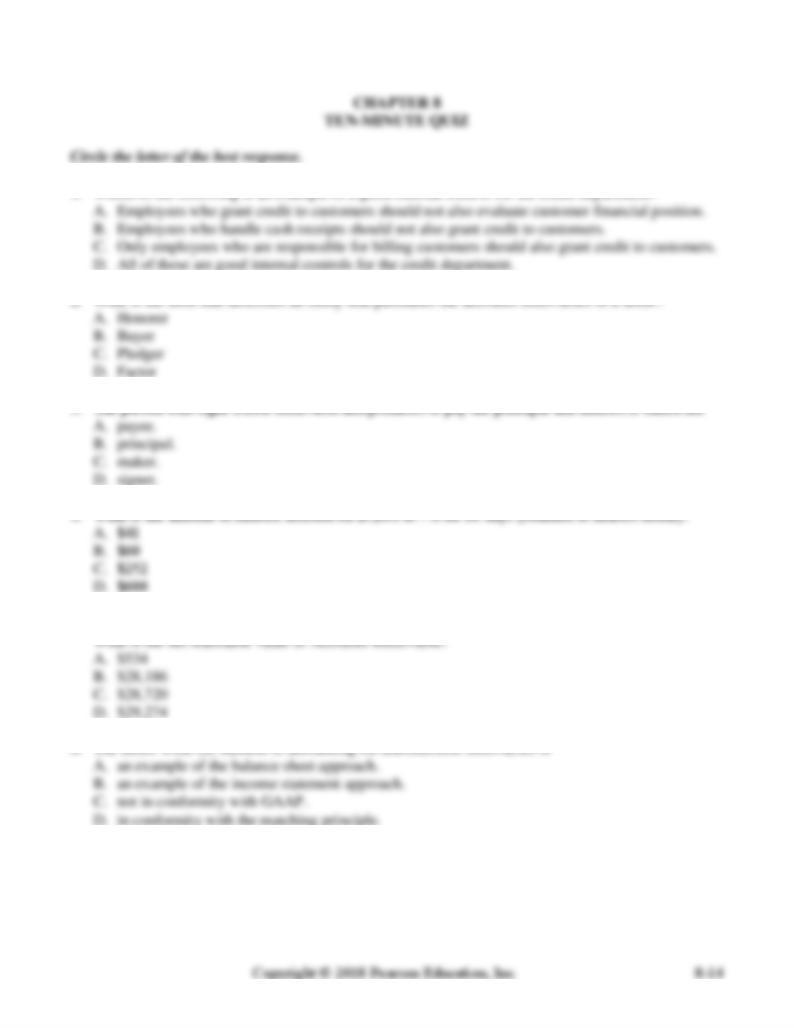
5. Heather’s Hair Products estimates that $534 of its $28,720 Accounts Receivable are uncollectible.
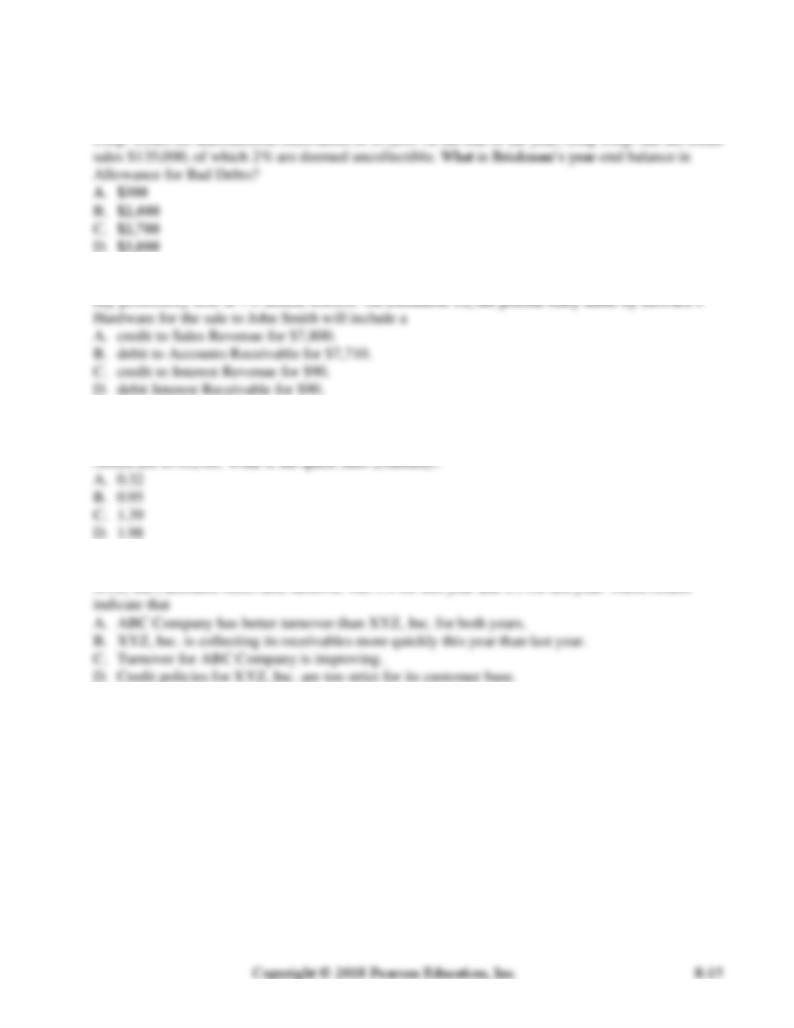
7. Gorp Corp. uses the percentage-of-sales method to account for uncollectible receivables. At the
beginning of the year, Allowance for Bad Debts has a credit balance of $1,500. During the year Gorp
8. On December 12, Howard’s Hardware sells materials for $7,800 to John Smith. Smith signs a 60-
9. At year-end, Urus Company has Cash of $15,500, Accounts Receivable of $52,300, Inventory of
$28,700, and Prepaid Expenses totaling $7,200. Total Current Liabilities are $48,800 and Total
10. Accounts receivable turnover for ABC Company was 8.7 for this year and 9.8 for last year. For
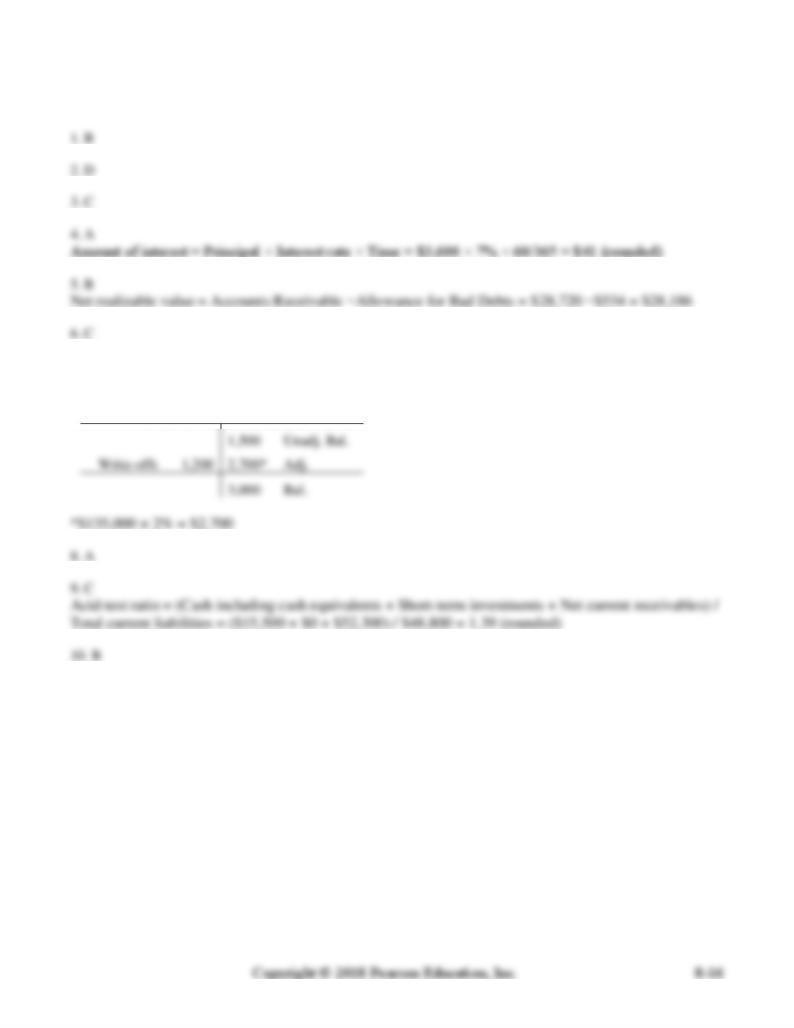
Answer Key to Ten-Minute Quiz:
7. D
Allowance for Bad Debts

Extra Critical Thinking Questions
Ethical Issue 8-1
E-Z Loan Co. makes loans to high-risk borrowers. E-Z borrows from its bank and then lends money to
people who have bad credit. The bank requires E-Z Loan to submit quarterly financial statements in
order to keep its line of credit. E-Z’s main asset is Accounts Receivable. Therefore, Bad Debts Expense
and Allowance for Bad Debts are important accounts.
Slade McMurphy, the controller of E-Z Loan, wants net income to increase in a smooth pattern rather
than increase in some periods and decrease in others. To report smoothly increasing net income,
McMurphy underestimates Bad Debts Expense in some periods. In other periods, McMurphy
overestimates the expense. He reasons that over time, the income overstatements roughly offset the
income understatements.
Is McMurphy’s practice of smoothing income ethical? Why or why not?
Ethical Issue 8-1: Solution
E-Z Loan’s practice of smoothing income is unethical because the controller deliberately underestimates
Bad Debts Expense in some periods and overstates the expense in other periods. The purpose is to
manipulate income. Instead, the company should be using accounting information, specifically the
company’s past collection history, to develop a consistent method of calculating the Allowance for Bad
Debts. This would be in conformance with the principles of consistency and reliability and would
represent the business truthfully to the bank.
Team Project 8-1
Companies want to maximize sales by extending credit to customers. However, this comes with risk.
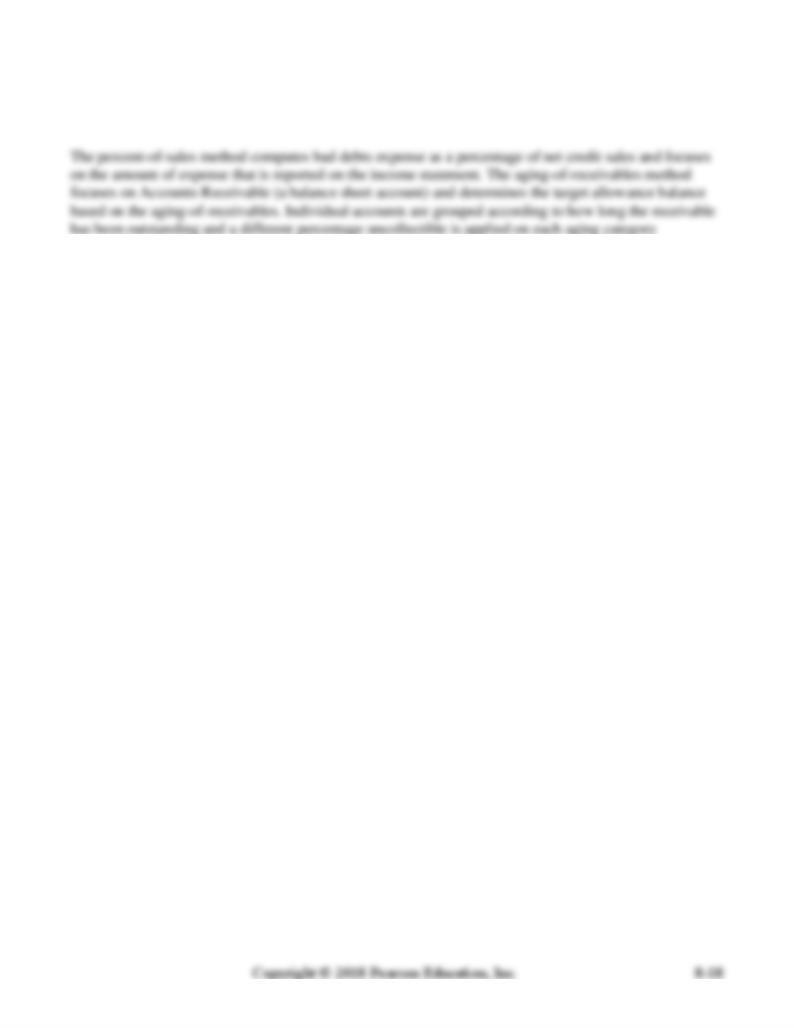
Communication Activity 8-1: Solution